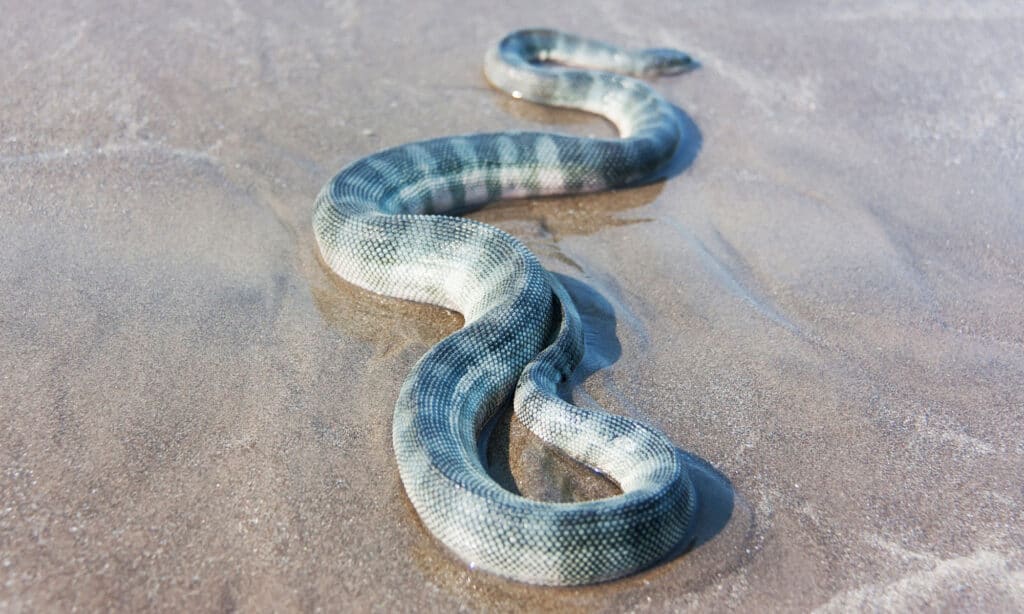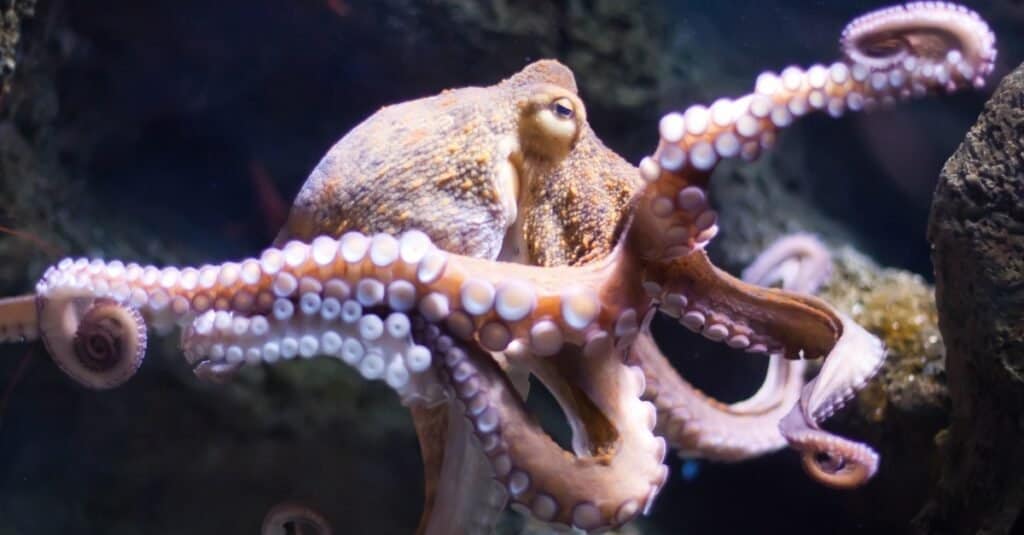Sea snakes are members of the Elapidae family and are found primarily in the Indian and Pacific Oceans. These 69 species are further split into seven unique genera, with most unable to survive on land.
Also known as the mesopelagic zone, existing beyond the range of sunlight, the “Twilight Zone” extends from 650 to 3300 feet (200 to 1000 meters) below the ocean’s surface. Due to this, the Twilight zone is cold and dark, and the only light source is the occasional bioluminescent light created by species living there.
Contrary to popular belief, many animals inhabit the Twilight zone permanently while others travel to and from the surface daily. The Twilight zone is home to a wide variety of species, from microscopic organisms to big animals. It is shocking to note that there have been several sightings of sea snakes in the Twilight zone. Curious to know why these snakes can be found in the sea’s Twilight zone? Keep reading.
Common Sea Snake Habitats and Behaviors

Sea snakes are often found in protected coastal waters and near river mouths.
©iStock.com/Ekaterina Borisova
A snake must belong to the Hydrophiinae or Laticaudinae subfamilies for it to be considered a sea snake, and all sea snakes are venomous except those that fall under the Emydocephalus. Most sea snake species are confined to the warm tropical seas of the Indian Ocean and the western Pacific Ocean. A few species of sea snakes can be found further into Oceania, but not in the Atlantic Ocean, the Caribbean, or along the North American coast north of Baja.
Sea snakes are often found in protected coastal waters and near river mouths. However, they also do well in various environments, such as coral reefs, clear water, and muddy or turbid water. Some species may venture on land, although most sea snakes are helpless if washed ashore. Also, sea snakes are usually found in saltwater, although some species prefer freshwater.
Like several of their land-based counterparts, most sea snakes are venomous, except for the genus Emydocephalus. Even though the majority of them are exceedingly venomous, they do not inject venom when they bite. Most sea snakes would rather avoid confrontation with humans or other animals than attack, except when hunting their prey. The only humans that have ever complained of sea snake bites are fishermen that accidentally caught one in their fishing net, and the only reason the sea snake bit them was that it felt threatened.
Animals in The Twilight Zone

The octopus can be found in the Twilight zone.
©iStock.com/aurigadesign
As established, there are more animals in the Twilight zone than we can imagine. The Twilight zone is home to more fish than the rest of the ocean combined. Most of these fish, and other creatures that inhabit the Twilight zone, are tiny, measuring only a few inches or less in length. The marine life that thrives in the Twilight zone must be able to resist its harsh conditions, which include rising water pressure and falling water temperature. These animals may have slimmer bodies to evade possible predators or darker bodies to blend in better with their shadowy surroundings. This region is home to octopus, squid, and hatchet fish; some whales even stop by to feed.
The majority of the animals that live in the Twilight zone are scarier than usual, with most of them being things that are only imagined. One common thing they all share, scary or not, is they are all uniquely suited to the life of cold and deep darkness in the twilight zone. With the water pressure at this point reaching 1500 pounds per square inch, all life in the Twilight zone has evolved to survive under harsh conditions. The majority of creatures in the Twilight zone have slimmer bodies to conceal themselves from prospective predators or darker bodies to better blend with the night. Others have bioluminescent light, which they occasionally use for camouflage, to detect the presence of predators, or even to draw in prey.
Why Snakes Can Be Found in The Deep Sea’s Twilight Zone

Sea snakes’ skin allows them to absorb up to 33% of the oxygen they require.
©Rich Carey/Shutterstock.com
Sea snakes are found in tropical waters of the Indian and Pacific Oceans and are typically associated with shallow water habitats like coral reefs and river estuaries. However, there is proof that sea snakes can reach the oceans’ twilight zone and have been seen hundreds of feet from the surface level hunting for food.
Records show that sea snakes only dive as deep as 164 to 328 feet (50 to 100 meters) mostly because they need to swim back to the surface to breathe in air at intervals, even if they can stay submerged for up to eight hours, and also breathe through their skin. Sea snakes require oxygen for breathing, unlike fish. To survive, every species needs to resurface occasionally. However, some sea snakes may remain submerged for up to eight hours. Most sea snakes surface every 30 minutes to breathe. That’s because these snakes’ skin allows them to absorb up to 33% of the oxygen they require. Similarly, they can eliminate 90% of their carbon dioxide.
There has been evidence of sea snakes diving deeper than they usually would, reaching the sea’s Twilight zone as far as 800 feet from the surface. Because sea snakes must return to the surface to obtain oxygen, these dives were considered impossible. However, there is proof that sea snakes can deal with decompression sickness, sometimes called the bends, by using gas exchange through their skin.
Despite the darkness in the Twilight zones, sea snakes that wander that deep do not seem to have a problem with not seeing. Along with their evolution to become aquatic creatures, sea snakes also had their eyesight evolve, making it possible to see prey and predators deep below the sea surface. Another advantage these species have is a paddle-like tail which makes swimming and diving easy for them. They also have flatter bodies that have evolved to help them glide better at sea.
Another reason sea snakes can dive as far as the Twilight zone is that they do not need to worry about ingesting saltwater. Sea snakes don’t drink salt water, but when they hunt and eat prey, they ingest a lot of salt. The snakes have developed unique sublingual glands to prevent overconsumption of salt. These glands that are beneath the snakes’ tongues stimulate the bloodstream to leak salt into the mouth, enabling the snake to simply flick its tongue to remove extra salt.
Up Next
Giant Sea Snakes: Discover the Largest Sea Snakes in the World
The Largest Sea Snake Ever: Discover an Ancient 40-foot-long Giant
Meet the Ancient Deep Sea Shark that Looks Like a Snake (and has 300 Teeth!)
The photo featured at the top of this post is © Roberto Romanin/Shutterstock.com
Discover the "Monster" Snake 5X Bigger than an Anaconda
Every day A-Z Animals sends out some of the most incredible facts in the world from our free newsletter. Want to discover the 10 most beautiful snakes in the world, a "snake island" where you're never more than 3 feet from danger, or a "monster" snake 5X larger than an anaconda? Then sign up right now and you'll start receiving our daily newsletter absolutely free.
Thank you for reading! Have some feedback for us? Contact the AZ Animals editorial team.






